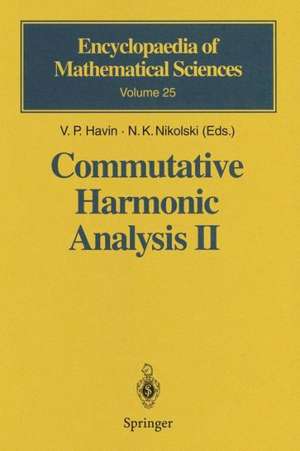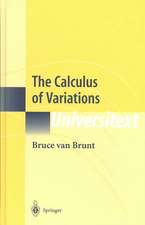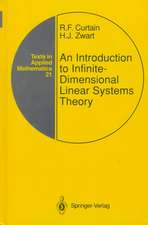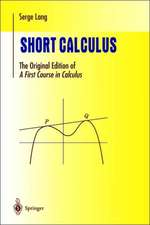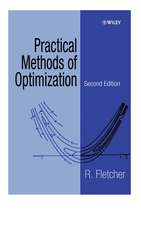Commutative Harmonic Analysis II: Group Methods in Commutative Harmonic Analysis: Encyclopaedia of Mathematical Sciences, cartea 25
Editat de V. P. Havin Traducere de D. Dynin Contribuţii de V.P. Gurarii Editat de N.K. Nikolski Traducere de S. Dyninen Limba Engleză Paperback – 14 oct 2012
Din seria Encyclopaedia of Mathematical Sciences
- 20%
 Preț: 568.20 lei
Preț: 568.20 lei - 15%
 Preț: 639.41 lei
Preț: 639.41 lei -
 Preț: 385.84 lei
Preț: 385.84 lei - 15%
 Preț: 638.11 lei
Preț: 638.11 lei -
 Preț: 386.61 lei
Preț: 386.61 lei - 18%
 Preț: 952.72 lei
Preț: 952.72 lei - 15%
 Preț: 655.60 lei
Preț: 655.60 lei - 18%
 Preț: 1117.82 lei
Preț: 1117.82 lei - 15%
 Preț: 640.06 lei
Preț: 640.06 lei - 18%
 Preț: 1112.60 lei
Preț: 1112.60 lei - 15%
 Preț: 648.24 lei
Preț: 648.24 lei - 15%
 Preț: 648.42 lei
Preț: 648.42 lei - 20%
 Preț: 555.79 lei
Preț: 555.79 lei - 18%
 Preț: 1234.32 lei
Preț: 1234.32 lei - 18%
 Preț: 1228.96 lei
Preț: 1228.96 lei - 18%
 Preț: 1125.55 lei
Preț: 1125.55 lei - 15%
 Preț: 642.51 lei
Preț: 642.51 lei - 18%
 Preț: 1126.17 lei
Preț: 1126.17 lei -
 Preț: 385.62 lei
Preț: 385.62 lei - 18%
 Preț: 950.63 lei
Preț: 950.63 lei - 15%
 Preț: 644.49 lei
Preț: 644.49 lei - 15%
 Preț: 644.63 lei
Preț: 644.63 lei - 18%
 Preț: 894.79 lei
Preț: 894.79 lei - 15%
 Preț: 643.16 lei
Preț: 643.16 lei - 15%
 Preț: 696.18 lei
Preț: 696.18 lei - 18%
 Preț: 952.89 lei
Preț: 952.89 lei - 18%
 Preț: 730.65 lei
Preț: 730.65 lei - 24%
 Preț: 682.14 lei
Preț: 682.14 lei
Preț: 390.63 lei
Nou
Puncte Express: 586
Preț estimativ în valută:
74.76€ • 81.17$ • 62.79£
74.76€ • 81.17$ • 62.79£
Carte tipărită la comandă
Livrare economică 23 aprilie-07 mai
Preluare comenzi: 021 569.72.76
Specificații
ISBN-13: 9783642638008
ISBN-10: 3642638007
Pagini: 340
Ilustrații: VIII, 328 p.
Dimensiuni: 155 x 235 x 18 mm
Greutate: 0.48 kg
Ediția:Softcover reprint of the original 1st ed. 1998
Editura: Springer Berlin, Heidelberg
Colecția Springer
Seria Encyclopaedia of Mathematical Sciences
Locul publicării:Berlin, Heidelberg, Germany
ISBN-10: 3642638007
Pagini: 340
Ilustrații: VIII, 328 p.
Dimensiuni: 155 x 235 x 18 mm
Greutate: 0.48 kg
Ediția:Softcover reprint of the original 1st ed. 1998
Editura: Springer Berlin, Heidelberg
Colecția Springer
Seria Encyclopaedia of Mathematical Sciences
Locul publicării:Berlin, Heidelberg, Germany
Public țintă
ResearchCuprins
1. Convolution and Translation in Classical Analysis.- 2. Invariant Integration and Harmonic Analysis on Locally Compact Abelian Groups.- References.- Author Index.
Textul de pe ultima copertă
Classical harmonic analysis is an important part of modern physics and mathematics, comparable in its significance with calculus. Created in the 18th and 19th centuries as a distinct mathematical discipline it continued to develop (and still does), conquering new unexpected areas and producing impressive applications to a multitude of problems, old and new, ranging from arithmetic to optics, from geometry to quantum mechanics, not to mention analysis and differential equations. The power of group theoretic ideology is successfully illustrated by this wide range of topics. It is widely understood now that the explanation of this miraculous power stems from group theoretic ideas underlying practically everything in harmonic analysis. This volume is an unusual combination of the general and abstract group theoretic approach with a wealth of very concrete topics attractive to everybody interested in mathematics. Mathematical literature on harmonic analysis abounds in books of more or less abstract or concrete kind, but the lucky combination as in the present volume can hardly be found in any monograph. This book will be very useful to a wide circle of readers, including mathematicians, theoretical physicists and engineers.
